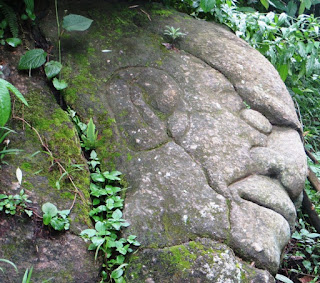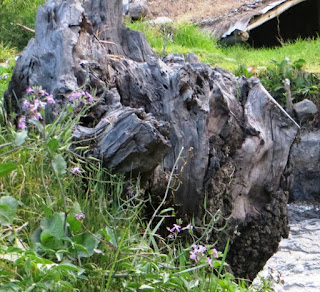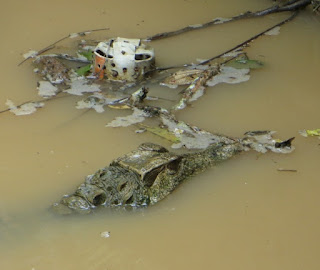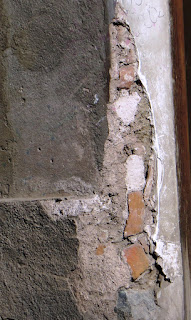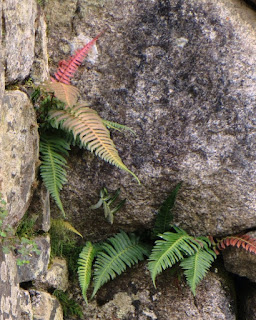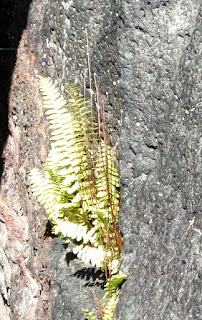(During my year of travel through Asia in 2014 there was
always a bit of down time to write a blog post and upload photos. This time, though, it seems I was always too
busy exploring South America or visiting with folks. Not a bad thing, because it’s given me time
to think about those experiences and search for the “same same different”
between countries. Instead of writing
about each country I visited, I’m going to start with a number of ideas that
flowed across borders.)
Years ago when we had just purchased our first “state of the
art” camera, we headed to Jasper National Park for a holiday and to play with
our new toy. While Cal focused on birds
and other wildlife, I discovered how fun it was to focus in on the tiny wildflowers,
or the rocks and rugged branches on the trees.
First off, they didn’t move so I could take the time to focus manually
as well as try out all the different settings and other gadgets that came with
the camera. I quickly fell in love with
the details I was focusing on.
I remember crouching on an alpine trail trying to see how
much I could zoom in on a tiny flower that was blowing gently in the wind,
having to place myself so my shadow didn’t block the sun and needing a fast
enough shutter speed to allow for the movement caused by the wind. In the pre digital era, I couldn’t just take
a dozen images and choose the best one. Finally, capturing what I thought was
going to be a great photo, I moved on.
And realized that a group of Japanese tourists had been watching
carefully what I was doing and then crowded around “my” flower to snap photos
of what must have been very important!
Over the years, my idea of what is interesting has been
modified by my passion for quilting.
Colours can be ideas for a quilt.
Lines and shapes can be quilting designs. I find myself feeling an object to see if
what I see/feel is the same or different. Learning about perspective in quilts
means that I often look for different angles to emphasize part of my subject or
to capture the sky. Years ago, a friend
shared the following quote with me - “trying to reason with some people is like
trying to describe the smell of the colour nine” - and although I understand
what she was getting at, I find that my favourite photos are trying to do just
that.
I don’t use a state of the art camera any more. Instead, I have a Canon Powershot that I can
use in automatic mode or make simple manual adjustments. It’s small enough to travel in my pocket or
attached to my backpack chest strap. Like my fellow traveler Mark taught me, I
take dozens of photos even if they aren’t perfectly composed, because you’re
bound to find something interesting. You won’t find any fancy editing to these
photos, usually just cropping to emphasize what looks interesting and to get
rid of what distracts. I’ll use autocorrect occasionally when my camera and I
disagree about the colours we saw. Some of the most interesting photos, to me, are the ones where I've asked my camera to go way beyond its comfort zone.
Here’s some of the colours, shapes and textures I discovered
in South America. Be sure to zoom in on
details, because that is usually what caught my eye.
Rough and rugged
The stark beauty of harsh landscapes has always fascinated
me. From the Argentinean Patagonia,
through the sub arctic Tierra del Fuego and then northward through the deserts
of Chili and the altiplano, the shapes and textures were breathtaking. How do living things survive in these environments? Stubbornness and determination, I think.
 |
| Seals, who I learned are not lazy, but exhausted after hours of fishing for dinner |
 |
Rest stop heading out from Torres del Paine. Then on the road to Ushuaia.
We all headed toward the ocean with the crystal clear reflections. No need for snacks when you can feast on this glory. |
 |
One of our very few "real" bush camps.
Just before the border into Argentina as we headed to Tierra del Fuego. |
 |
Beagle Channel. I thought this was some kind of statue.
It was the wreck of an old building. |
 |
| Sheep wool |
 |
| Abandoned train on the salt flats. Rust is always a great texture |
 |
| Salt desert on the altiplano. Stubbornness and determination on the part of the plants |
 |
| Near Macchu Pichu. Hmm, is this coming our way? |
Lush and green
(flowers and such)
In direct contrast were the areas of abundant rainfall –
the Pantanal of Brazil, the cloud forests and the Amazon rain forest. Hundreds
of shades of green dripping with moisture and brightly coloured flowers that
looked almost unreal. Few of the plants
familiar to me, so I simply enjoyed their nameless elegance. The occasional one
that I recognized as one that could be a pampered houseplant where I live, but
was looking so much more at home in the wild.
 |
| Paperbark tree (eucalyptus) |
 |
| In the desert, if you look carefully, there are these wee plants determined to make a go. |
 |
| Coming toward Perito Moreno Glacier through cattle country. Everything seemed vaguely familiar. Ranchers removed all the natural vegetation, discovered the poor soil wouldn't grow grain and then planted Alberta grass to try and stop erosion and to feed cows. Of course it looked familiar! Except the mountains were toward the east. |
 |
| Tagua seed. Vegetable ivory. Eco friendly. |

 |
Following the bikes down the death road, which drops through the cloud forest toward the Amazon.
Everything is willing to grow with the moisture, a bit lower altitude and a richer soil. |
 |
| Exploring the edges of Lake Titicaca |
 |
| Herbal remedy. Once my guide, Juan, realized I wasn't going to die (was just slow), we had these fascinating conversations about the many plants we passed along the trail. |
 |
| Lupins originated in the Andes. Apparently, the higher the altitude and the colder the temperatures, the bigger and more vibrant are the the flowers. |
 |
| Poisonous if it touches your skin. Our guide told a politically incorrect story about this. |
 |
| Market in Arequipa. Shopping for a cooking class. |
 |
| Leaf cutter ants make the best decorations |
 |
| Found bracelets made of these seeds through out the Andes. Designed to protect the wearer from the evil eye |
 |
| Tagua seed before cutting |
 |
| Ecuadoran cocoa. Mmmm |
 |
| the seeds unshelled (L) and with shell removed and ready for roasting |
 |
| Palm leaves cleaned and drying. Next step, Panama Hats. |
 |
| Bananas. Yes, pink |
 |
| What the wild ginger looks like when it has gone to seed |
 |
| the ridges you can barely see are terraces from the local indigenous (not Inka) people pre Columbian |
 |
| Coffee beans dried but not shelled yet |
 |
| Roasted coffee beans. |
 |
| rather artsy from my iphone in dim light and at maximum zoom |
 |
| Natural remedy apparently |
Birds and bees (and
other bugs and beasties)
The joy of slow travel is that you have the opportunity to
bump into the locals – the birds that are watching you from the trees, the
insects perfectly adapted to their environment and all sorts of other
creatures. My camera doesn’t have the
power of the big lens state of the art cameras, but the ability to take a quick
photo as something flits by means that I sometimes get surprising results.
Sky (and Water)
There were some pretty marvelous skies during my travels. Partly, I think, because the days were close
to twelve hours in length which meant we were almost always out and about for
sunrise and sunset. But even during the
daylight hours, the clouds and the quality of the light was so different to
what I live with in Northern Alberta. My camera and I have reached an
understanding about sky photos – it has some very clear ideas of what colour
things are (black skies get lightened up and pinks are a more friendly orange)
and I just go with that idea. In
exchange, it will take photos without flash or tripod in almost total darkness.
Water reflects the sky, or changes depending on the sky, or enhances the sky. Water means oceans or lakes or rivers. All of which appeal to this land locked prairie girl.
 |
| Standing on Copacabana beach with my back to 200,000 partying Brazilians |
 |
| The reward for getting up early |
 |
| Huge cactus in the Atacama. Used as the only available wood for roof beams and furniture. |
 |
| Yup, the moon with my wee camera. Through a telescope at San Pedro de Atacama. |
 |
Sunset on the salt flats.
Flags of the countries participating in the Dakar rally which had passed through here the year before. |
 |
| The sky was out there somewhere. Following the bicycles down the death road. |
 |
| Lake Titicaca from the Bolivia side. |
 |
| and from the Peruvian side |
 |
| Quilotoa (a crater lake in the cloud forest of Ecuador). We hiked part way around the rim then back to our hostel. |
 |
| A crazy long drive day with truck getting stuck, overturned vehicles and roads that made Northern Alberta cut lines look like paved highways. But there were these incredible skies. |
 |
| I didn't realize that I was getting a Caribbean vacation! |
Man made beauty
It was fascinating to see the way things are built in South
America. The most commonly available
material was adobe – or bricks made of local dirt, water, and some plant fiber
to make it stick together. It might be
plastered over, sculpted and painted to look almost like carved European
stonework. Even the new multistory
buildings were built with adobe bricks as the internal structure. With a little
wear and tear, the internal adobe showed through in its delightful roughness. In contrast, the Inkas built their holy
places of stone and the Spanish made use of these stones to build their own holy
places. So, unlike the adobe which needed to be constantly maintained, these structures
are as they were five hundred years ago
 |
| Market in Rio de Janiero. I can only imagine how early the shopkeeper got there to arrange these peppers. |
 |
Dancers at the Sambadrome. Really far away. In the almost dark.
Cool artsy swirl of colours. |
 |
| Restored adobe wall. But leave a bit of the old to admire |
 |
View from the loo.
An incredible over the top rest stop with this great weathered door to the ladies loo. |
 |
Buenos Aires. Memorial to the war for Las Malvinas (Falkland Islands)
Note the child's runner added. |
 |
| view from the loo |
 |
very close up of some great grafitti.
Artist making use of the roughness of the wall |
 |
Eddie and greenery.
Famous grafitti artist was doodling while having a beer at the bar. |
 |
| Alabaster (a type of stone) was used in church windows |
 |
Memorial to the disappeared. Very subtle.
Move from the traditional white scarf stensil to the dove of peace. |
 |
Incredible goldwork embroidery.
Original flag of the province of Tierra del Fuego and Las Malvinas |
 |
| Another view from a loo |
 |
| My camera really likes playing with water at extreme zoom |
 |
| Statue to the indigenous peoples of Chili |
 |
| Mummified body |
 |
| A hat. Really. |
 |
| Although the Inka had no system of writing, this is what they used to keep track of accounts. |
 |
Our estancia "Los Protreros" for the miles of dry mount walls that were built
by indigenous people under the direction of the priests.
Made me think of cotters homes in Scotland |
 |
| Hmm can I figure out how to do this knot? |
 |
| When you live in a harsh land, you plant what will survive |
 |
Salt flats. Mined for salt bricks. Looks like a layered dessert.
Left furrows in the ground just like when cutting peat. |
 |
| Our oasis after too much altitude and too many miles. |
 |
Church in San Pedro de Atacama from the 1600s.
Recently the adobe was all restored. The original roof is cardon (cactus) bound with llama leather. |
 |
Mausoleum in Recoleta cemetary Buenos Aires. Famous general.
Replicated the mountains he spent his life fighting in. |
 |
| Our hotel in Uyuni was an oasis in a very harsh environment. Pizza, hot showers and warm beds, and some marvelous textures in the nooks and crannies. Someone had taken the time to make a functional wall into a work of art. |
 |
| Some cool statues made of mechanical parts. |
 |
| A rain shelter along the death road with some added art. |
 |
With the weather, the bikers were soon mud covered. Through several layers of clothing.
This is the back of a biker at the end of the ride. Great idea for a quilting pattern |
 |
| The indigenous ladies of La Paz wore these beautiful hand made hats felted from local wool. They were passed from mother to daughter. Every day hats would have a simple ribbon, but I did see a couple of obviously wealthy Aymara women with hats embellished with jewels that matched their equally stunning clothes. |
 |
Knitted cap from well before the Spanish arrived.
Textiles survive a long time on the altiplano with the cold and the dry conditions. |
 |
| Contemporary statue on one of the plazas in the historical section of La Paz |
 |
| More very old textiles. Burial straps, so woven of higher quality wool and preserved around the corpse rather than roughly used, worn out and then discarded. The textiles were fascinating for their still vibrant colours and complex designs still being used today. |
 |
| Farming on the way to Lake Titicaca. Stuking the grain because machinery isn't an option. |
 |
| Exploring Tiwanaku ruins on the way from La Paz to the border. Pre Inka. the first of many ruins. |
 |
| Dry mount stone house on the shore of Lake Titicaca. |
 |
| Isla de la Luna. Our first Inka ruin. |
 |
| The first of many sets of Inka ruins in and around Cuzco. Each a little different. I never got tired of the stories. |
 |
| Original water pathways from 13th century |
 |
| I was tempted to reach over and put a few of these balls of wool in my pocket. |
 |
| Modern art at Qorikancha - museum in Cuzco. A "map" of the Inka empire with Cuzco as the navel of the world |
 |
| Our homestay had beautiful beds and warm blankets and this wonderful window covering |
 |
| our hostess' all purpose shawl, backpack, carrier of everything. |
 |
| As the plaster weathers, you can see the old adobe bricks |
 |
| Rust. Totally incidental to the other cool stuff at the Chan Chan ruins |
 |
| After a long day of travel - flight from the Galapagos then four hour drive through the mountains to Cuenca, I was walking through deserted streets looking for some dinner. This is what I saw as I came around the corner and into the main square - where I found pubs with live music and a lovely quiet restaurant with great food. |
 |
Beautiful new plaster to update the wall, but leave a bit of the old showing.
Very appealing to this quilter. |
 |
| Wee cafe in the old cathedral (now a museum) |
 |
| In Cuenca, when you are plastering the wall of a hat shop, what else would you do for decoration? |
 |
| South American cemeteries are fascinating. This one in Quito had lots of well weathered adobe buildings showing their inner structure |
 |
| Guayasamin museum. Couldn't take photos inside, but there was cool stuff outside. |
The Galapagos with a
new camera: different light, colour and detail
My poor camera started to be very temperamental after 23,000
photos, a dust storm in Dunhuang (China), snorkelling in a not entirely
waterproof container in Brazil, and then a drop from my hands to a cement
sidewalk at Ingapirca. So a new wee
cameral entered the picture just before traveling to the Galapagos. I had no choice at all – it would seem that
South Americans use smart phones for photos or travel to the US on
vacation and buy a camera there. After much searching, I discovered
a Sony Cybershot in a computer shop in Cartagena and the choice was made. The advantage of this new camera is a lot
more pixels so way more detail within its range of where it will focus. The disadvantage is that it is totally point
and shoot with a very limited zoom. It
made up its mind what to focus on (not always the pretty flower I wanted to
catch) and how much light it needed – daylight was good. But, I did get some pretty special photos of
a very special place. (Update, my Canon Powershot has been repaired and should be back home soon)



 |
| I think that the Sally Lightfoot crabs are this beautiful colour to contrast with the black volcanic rocks! |
 |
| Responsible shell collecting in the National Park |
 |
| Pelican. Check out the detail my wee camera gave to the feathers |
 |
| Shipwreck on one of the beaches. This is what is left of the beams. |
 |
| Boobie and baby |
 |
| Bad hair day |
 |
| Underwater. From our dinghy. |
 |
| Marine iguana skull, I think |
 |
| Blue whale (YES!!) one of several that came to check out our boat |
 |
| Crumbly bit of lava |
 |
I have dozens of seal photos.
This little one was a few days old - old enough for mum to leave and go fishing. |
 |
These are remnants of a mangrove forest - tsunami from one of the earthquakes off Chili flooded this area.
Mangroves don't disintegrate like other woods. |
 |
| Beached whale from 8 years ago. Great colour contrasts |
 |
| Chinese hats (limpets) very much alive and well |
 |
| Land iguana |
 |
| Great quilting pattern. Tracks of a land iguana actually |
 |
| Galapagos penguin. Not the one I swam with. |
 |
Turtle rescue center. The rooster and the leaves made a more colourful photo.
And there is an ongoing discussion about why chickens cross roads. |
 |
| My iphone at its very limit of zooming gives an interesting look |
 |
| mushrooms |

















































